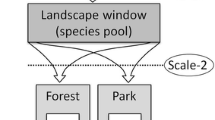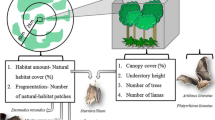Abstract
Data on species distribution and abundance are the foundation of population ecology. However, due to difficulties in surveying bats, abundance estimates for tree-roosting microchiropterans are non-existent. Therefore, our objective was to develop methods for estimating colony abundance and density, taking as our model Rafinesque’s big-eared bat Corynorhinus rafinesquii, a species of conservation concern found in cypress-gum swamps of the southeastern United States. We searched 123 transects at eight study sites in the Coastal Plain of Georgia, USA to locate and characterize diurnal summer roosts of C. rafinesquii. We modeled the relationship between the number of bat colonies and landscape-scale habitat variables with zero-inflated negative binomial regression and used Akaike’s information criterion to select the most parsimonious models. We generated a predictive density map to identify areas of high colony density and to estimate overall abundance. Colony density was predicted by the duration of wetland flooding, wetland width, and study site. Application of the regression model to a GIS indicated there were 3,734 colonies containing 6,910 adult bats on the eight study sites. Predicted density ranged from 0.07 colonies/ha and 0.07 adult bats/ha in saturated wetlands to 0.47 colonies/ha and 1.18 adult bats/ha in semi-permanently flooded wetlands. This study is the first to estimate density and abundance of forest-dwelling microchiropterans over a large area. Such data can serve as a baseline for future work on population trends in C. rafinesquii. In addition, our approach could be replicated for other bat species with moderately cryptic roosts.



Similar content being viewed by others
References
Arnett EB, Huso MMP, Schirmacher MR, Hayes JP (2011) Altering turbine speed reduces bat mortality at wind-energy facilities. Front Ecol Environ 9:209–214
Arroyo-Cabrales J, Ticul Alvarez Castaneda S (2008) Corynorhinus rafinesquii. IUCN Red List of Threatened Species, Gland, Switzerland. http://www.iucnredlist.org/apps/redlist/details/17600/0
Atkins DC, Gallop RJ (2007) Rethinking how family researchers model infrequent outcomes: a tutorial on count regression and zero inflated models. J Fam Psychol 21:726–735
Barclay RMR, Harder LD (2003) Life histories of bats: life in the slow lane. In: Kunz TH, Fenton MB (eds) Bat ecology. University of Chicago Press, Chicago, pp 209–253
Brigham RM (2007) Bats in forests: what we know and what we need to learn. In: Lacki MJ, Hayes JP, Kurta A (eds) Bats in forests: conservation and management. Johns Hopkins University Press, Baltimore, pp 1–16
Brigham RM, Vonhof MJ, Barclay RMR, Gwilliam JC (1997) Roosting behavior and roost-site preferences of forest-dwelling California bats (Myotis californicus). J Mammal 78:1231–1239
Burnham KP, Anderson DR (2002) Model selection and multimodel inference: a practical information-theoretic approach, 2nd edn. Springer, New York
Carter TC (2006) Indiana bats in the Midwest: the importance of hydric habitats. J Wildl Manage 70:1185–1190
Carver BD, Ashley N (2008) Roost tree use by sympatric Rafinesque’s big-eared bats (Corynorhinus rafinesquii) and southeastern myotis (Myotis austroriparius). Am Midl Nat 160:364–373
Clark MK (2003) Survey and monitoring of rare bats in bottomland hardwood forests. In: O’Shea TJ, Bogan MA (eds) Monitoring trends in bat populations of the United States and territories: problems and prospects. U.S. Geological Survey, Fort Collins, Colorado, pp 79–90
Clement MJ (2011) Roosting ecology of Rafinesque’s big-eared bat and southeastern myotis in the Coastal Plain of Georgia. Doctoral Thesis. University of Georgia, Athens, Georgia, USA
Clement MJ, Castleberry SB (2011) Comparison of survey methods for Rafinesque’s big-eared bats. In: Loeb SC, Lacki MJ, Miller DA (eds) Conservation and management of eastern big-eared bats: a symposium. U.S. Forest Service Southern Research Station, Clemson, SC, pp 147–157
Clement MJ, Castleberry SB (2012) Summer tree roost selection by Rafinesque’s big-eared bat. J Wildl Manage. doi:10.1002/jwmg.456
Cowardin LM, Carter V, Golet FC, LaRoe ET (1979) Classification of wetlands and deepwater habitats of the United States. U.S. Department of the Interior, Washington, DC
Crampton LH, Barclay RMR (1998) Selection of roosting and foraging habitat by bats in different-aged aspen mixedwood stands. Conserv Biol 12:1347–1358
Duff AA, Morrell TE (2007) Predictive occurrence models for bat species in California. J Wildl Manage 71:693–700
Fenton MB (1997) Science and the conservation of bats. J Mammal 78:1–14
Ford WM, Menzel MA, Rodrigue JL, Menzel JM, Johnson JB (2005) Relating bat species presence to simple habitat measures in a central Appalachian forest. Biol Conserv 126:528–539
Foster MS (1992) Tent roosts of Macconnell’s bat (Vampyressa macconnelli). Biotropica 24:447–454
Frick WF, Pollock JF, Hicks AC, Langwig KE, Reynolds DS, Turner GG, Butchkoski CM, Kunz TH (2010) An emerging disease causes regional population collapse of a common North American bat species. Science 329:679–682
Georgia Forestry Commission (2009) Georgia’s best management practices for forestry. Georgia Forestry Commission, Macon
Gooding G, Langford JR (2004) Characteristics of tree roosts of Rafinesque’s big-eared bat and southeastern bat in northeastern Louisiana. Southwest Nat 49:61–67
Graves AT, Fajvan MA, Miller GW (2000) The effects of thinning intensity on snag and cavity tree abundance in an Appalachian hardwood stand. Can J For Res 30:1214–1220
Greaves GJ, Mathieu R, Seddon PJ (2006) Predictive modelling and ground validation of the spatial distribution of the New Zealand long-tailed bat (Chalinolobus tuberculatus). Biol Conserv 132:211–221
Grueber CE, Nakagawa S, Laws RJ, Jamieson IG (2011) Multimodel inference in ecology and evolution: challenges and solutions. J Evol Biol 24:699–711
Guisan A, Thuiller W (2005) Predicting species distribution: offering more than simple habitat models. Ecol Lett 8:993–1009
Hayes JP (2000) Assumptions and practical considerations in the design and interpretation of echolocation-monitoring studies. Acta Chiropterol 2:225–236
Hook DD (1984) Waterlogging tolerance of lowland tree species of the South. South J Appl For 8:136–149
Hurst TE, Lacki MJ (1999) Roost selection, population size and habitat use by a colony of Rafinesque’s big-eared bats (Corynorhinus rafinesquii). Am Midl Nat 142:363–371
Jaberg C, Guisan A (2001) Modelling the distribution of bats in relation to landscape structure in a temperate mountain environment. J Appl Ecol 38:1169–1181
Johnson RL, Beaufait WR (1965) Water tupleo (Nyssa aquatica L.). In: Fowells HA (ed) Silvics of forest trees of the United States. U.S. Department of Agriculture, Washington, DC, pp 284–286
Jones C (1977) Plecotus rafinesquii. Mammalian Species 69:1–4
Kunz TH, Arnett EB, Erickson WP, Hoar AR, Johnson GD, Larkin RP, Strickland MD, Thresher RW, Tuttle MD (2007) Ecological impacts of wind energy development on bats: questions, research needs, and hypotheses. Front Ecol Environ 5:315–324
Kunz TH, Betke M, Hristov NI, Vonhof MJ (2009) Methods for assessing colony size, population size, and relative abundance of bats. In: Kunz TH, Parsons S (eds) Ecological and behavioral methods for the study of bats. Johns Hopkins University Press, Baltimore, pp 133–157
Lambert D (1992) Zero-inflated Poisson regression, with an application to defects in manufacturing. Technometrics 34:1–14
Loeb SC, Lacki MJ, Miller DA (2011) Conservation and management of eastern big-eared bats: an introduction. In: Loeb SC, Lacki MJ, Miller DA (eds) Conservation and management of eastern big-eared bats: a symposium. U.S. Forest Service Southern Research Station, Clemson, SC, pp 1–12
MacKenzie DI, Nichols JD, Lachman GB, Droege S, Royle JA, Langtimm CA (2002) Estimating site occupancy rates when detection probabilities are less than one. Ecology 83:2248–2255
Medlin RE Jr, Risch TS (2008) Habitat associations of bottomland bats, with focus on Rafinesque’s big-eared bat and southeastern myotis. Am Midl Nat 160:400–412
Menzel MA, Menzel JM, Ford WM, Edwards JW, Carter TC, Churchill JB, Kilgo JC (2001) Home range and habitat use of male Rafinesque’s big-eared bats (Corynorhinus rafinesquii). Am Midl Nat 145:402–408
Miles AC, Castleberry SB, Miller DA, Conner LM (2006) Multi-scale roost-site selection by evening bats on pine-dominated landscapes in southwest Georgia. J Wildl Manage 70:1191–1199
Milne DJ, Fisher A, Pavey CR (2006) Models of the habitat associations and distributions of insectivorous bats of the Top End of the Northern Territory, Australia. Biol Conserv 130:370–385
Min Y, Agresti A (2005) Random effect models for repeated measures of zero-inflated count data. Stat Model 5:1–19
Nagelkerke NJD (1991) A note on a general definition of the coefficient of determination. Biometrika 78:691–692
NARSAL (1998) Landsat landcover 44 class. Natural Resources Spatial Analysis Laboratory, University of Georgia, Athens, GA. http://gis1.state.ga.us/download.asp?dataID=18756
O’Shea TJ, Bogan MA, Ellison LE (2003) Monitoring trends in bat populations of the United States and territories: status of the science and recommendations for the future. Wildl Soc Bull 31:16–29
R Development Core Team (2011) R: a language and environment for statistical computing. The R Foundation for Statistical Computing, Vienna. http://www.r-project.org
Rebelo H, Jones G (2010) Ground validation of presence-only modelling with rare species: a case study on barbastelles Barbastella barbastellus (Chiroptera: Vespertilionidae). J Appl Ecol 47:410–420
Rice CL (2009) Roosting ecology of Corynorhinus rafinesquii (Rafinesque’s big-eared bat) and Myotis austroriparius (southeastern myotis) in tree cavities found in a northeastern Louisiana bottomland hardwood forest streambed. Master of Science Thesis. University of Louisiana at Monroe, Monroe, Louisiana, USA
Russo D, Cistrone L, Jones G, Mazzoleni S (2004) Roost selection by barbastelle bats (Barbastella barbastellus, Chiroptera: Vespertilionidae) in beech woodlands of central Italy: consequences for conservation. Biol Conserv 117:73–81
Sedgeley JA, O’Donnell CFJ (1999) Factors influencing the selection of roost cavities by a temperate rainforest bat (Vespertilionidae: Chalinolobus tuberculatus) in New Zealand. J Zool 249:437–446
Sparks DW, Ritzi CM, Duchamp JE, Whitaker JO (2005) Foraging habitat of the Indiana bat (Myotis sodalis) at an urban–rural interface. J Mammal 86:713–718
Trousdale AW, Beckett DC (2005) Characteristics of tree roosts of Rafinesque’s big-eared bat (Corynorhinus rafinesquii) in southeastern Mississippi. Am Midl Nat 154:442–449
Trousdale AW, Beckett DC, Hammond SL (2008) Short-term roost fidelity of Rafinesque’s big-eared bat (Corynorhinus rafinesquii) varies with habitat. J Mammal 89:477–484
USFWS (2004) National wetland inventory database. U.S. Department of Interior, Washington, DC. http://gis1.state.ga.us/download.asp?dataID=39621
Vonhof MJ, Fenton MB (2004) Roost availability and population size of Thyroptera tricolor, a leaf-roosting bat, in north-eastern Costa Rica. J Trop Ecol 20:291–305
Watrous KS, Donovan TM, Mickey RM, Darling SR, Hicks AC, Von Oettingen SL (2006) Predicting minimum habitat characteristics for the Indiana bat in the Champlain Valley. J Wildl Manage 70:1228–1237
Weller TJ (2007) Assessing population status of bats in forests: challenges and opportunities. In: Lacki MJ, Hayes JP, Kurta A (eds) Bats in forests: conservation and management. Johns Hopkins University Press, Baltimore, pp 263–292
Wharton CH (1978) The natural environments of Georgia. Georgia Department of Natural Resources, Atlanta
Wiles GJ, Johnson NC (2004) Population size and natural history of Mariana fruit bats (Chiroptera: Pteropodidae) on Sarigan, Mariana Islands. Pac Sci 58:585–596
Williams BK, Nichols JD, Conroy MJ (2002) Analysis and management of animal populations. Academic Press, San Diego
Willis CKR, Voss CM, Brigham RM (2006) Roost selection by forest-living female big brown bats (Eptesicus fuscus). J Mammal 87:345–350
Acknowledgments
We thank Casey Carpenter and Jeremy Adams for field assistance. The Nature Conservancy and the Georgia Department of Natural Resources provided site access and housing. Mark Ford, Karl Miller, Nate Nibbelink, Jim Peterson, and anonymous reviewers provided helpful comments on the manuscript. Funding was provided by the Georgia Department of Natural Resources, Wildlife Resources Division and the D. B. Warnell School of Forestry and Natural Resources at the University of Georgia.
Author information
Authors and Affiliations
Corresponding author
Rights and permissions
About this article
Cite this article
Clement, M.J., Castleberry, S.B. Estimating density of a forest-dwelling bat: a predictive model for Rafinesque’s big-eared bat. Popul Ecol 55, 205–215 (2013). https://doi.org/10.1007/s10144-012-0356-z
Received:
Accepted:
Published:
Issue Date:
DOI: https://doi.org/10.1007/s10144-012-0356-z




